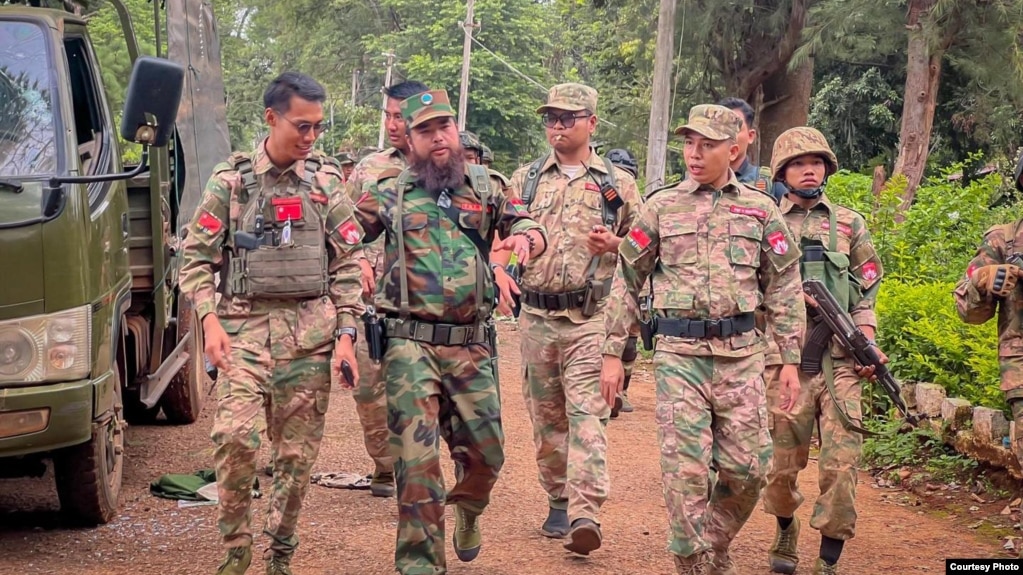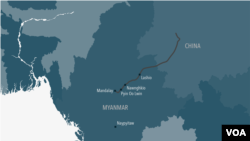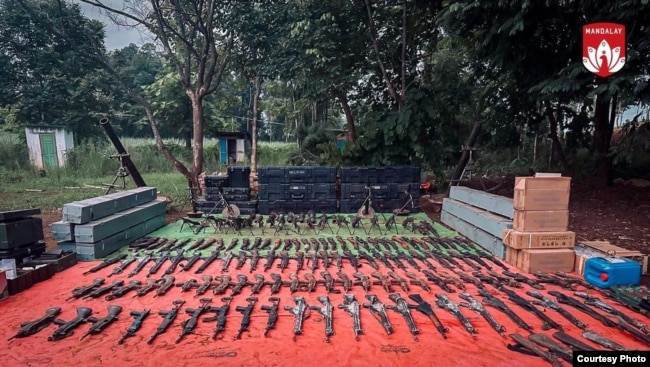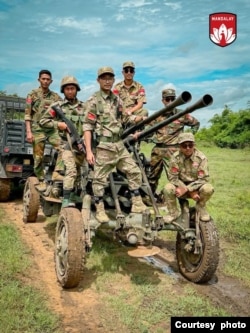
Anti-junta forces captured a vital town near Myanmar’s heartland this week, bolstering their position against the military junta. The offensive, in northern Shan state, involved a coordinated effort by various resistance groups, including the People’s Defense Forces (Mandalay) and the Three Brotherhood Alliance.
The PDF (Mandalay) is made up largely of young, educated professionals and is one of several armed groups formed by Myanmar’s shadow government, the National Unity Government (NUG), which hopes to restore democratic rule in the country.
During a weekslong battle that culminated Wednesday with the seizure of Nawnghkio Township, the resistance forces seized a large cache of weapons and ammunition from several government army bases surrounding the town. These included a multi-rocket launcher system, providing a significant boost to anti-junta military capabilities.

In an interview with VOA on Thursday, PDF (Mandalay) spokesperson Osmond emphasized the importance of capturing Nawnghkio, highlighting its strategic military value and the potential to shift the balance of power in the region.
“Nawnghkio town borders the Mandalay region and Mount Shan. Therefore, we were able to seize a geographically important place,” he said. “The operation started on June 25, coinciding with the second part of the 1027 operation, and the town was completely captured on July 10, two weeks later.”
Operation 1027 refers to a highly successful rebel offensive begun on October 27, 2023.
The PDF (Mandalay) was joined in the assault by elements of the Ta’ang National Liberation Army (TNLA), an ethnic force based in northern Shan state. The PDF (Mandalay) confirmed Thursday in a separate statement that the combined forces had captured the junta’s last remaining military base in Nawnghkio Township.
“All the weapons and ammunition we have seized will be used to eradicate the military dictatorship,” said the PDF (Mandalay) spokesperson, who added that the resistance fighters had captured more than 100 prisoners of war.
“Among the prisoners of war taken by us, some willingly surrendered and some were captured during battle,” said the spokesperson. “We also arrested Lieutenant Colonel Hlaine Tun Aung, as he was attempting to escape from his base camp” near Mandalay. “We pursued him and were finally able to catch him and put him under arrest.”
Key town at crossroads
In a phone interview with VOA, former army Major Naung Yoe explained the strategic significance of the region.
Naung Yoe, along with other former soldiers from the Myanmar military, fled the country after the 2021 coup and joined a civil disobedience group known as Peoples Goal, based in the Thai-Myanmar border region.
“By capturing Nawnghkio, the resistance forces can now control the Mandalay-Lashio road,” Naung Yoe said.

The army still controls the supply route from Mandalay to Pyin Oo Lwin, another strategically important town near Mandalay and home to one of the military’s primary training academies. But the military has “now lost the Mandalay-Lashio route, showing that junta forces can’t completely secure their ground supply routes to this and other areas in upper Shan state.”
Naung Yoe also said the road running through Nawnghkio was the starting point for the military junta to send support overland to its troops in northern Shan state. “Now the junta can no longer use these crucial routes.”
Trade route with China
Nawnghkio is also located on Myanmar’s most important trade route between Mandalay and China.
“This route is now controlled by revolutionary forces, delivering a major trade blow to the junta,” Naung Yoe said. “China will need to reach an agreement to reopen the route, since it has a such significant impact on trade.”
The former army major also pointed to the significance of weapons captured by the resistance forces, many of which the rebels could not buy.
“The seized arsenal includes advanced weaponry such as howitzers, missile launchers, 84 mm Carl Gustaf anti-tank weapons, anti-aircraft guns and infantry-support machine guns. These tactical military weapons will aid in offensives in heartland areas,” he said.
“The anti-aircraft weapons obtained from the PDF (Mandalay) can now threaten the junta’s aircraft, providing a significant strategic advantage,” Naung Yoe added. “In terms of military strategy, these captured weapons make the resistance forces more capable and enhance their long-term prospects.”

Junta response
As of Friday, the Myanmar junta had not officially addressed its losses in Nawnghkio. On Tuesday, however, it released a video about recent battles for the nearby town of Lashio, headquarters of the junta’s northeastern command.
Attacks on the town, led by the PDF (Mandalay), TNLF and another ethnic armed group known as the Myanmar National Democratic Alliance Army, or MNDAA, were briefly successful in capturing a military base but were largely thwarted by junta airstrikes.
In the video, junta spokesperson Major General Zaw Min Tun blames civilian deaths on rebel forces.
“The combined armed group started attacks against Lashio on July 3, firing short-range rockets and launching drone attacks randomly against the town daily from afar,” Zaw Min Tun asserted. “As a result, 18 innocent civilians were killed and another 24 were wounded.”
The junta spokesperson went on to describe what he called an alliance between the MNDAA and the National Unity Government, which has yet to acknowledge any such alliance.
TNLA spokeswoman Lway Yay Oo told VOA by phone that the deaths of civilians in Lashio were the result of the military’s shelling, not attacks by the resistance groups.
Operation 1027, Phase II
“In the 16 days of the second phase of the 1027 Operation [started June 25], more than 40 military bases in northern Shan state have been captured by the TNLA and the combined resistance armed groups,” Yay Oo said.
“Since the first phase of the operation, our joint forces have more experience, so this time around it is easier to face the military, because we know what to expect,” she said. “Also, some of soldiers from the junta military have deserted and have joined our side.”
Yay Oo said the Three Brotherhood Alliance, which comprises her TNLA and two other ethnic armies, has joined forces for the second phase with other rebel forces including the PDF (Mandalay) and other PDF groups.
“That is the way this revolution will be won, by fighting together to abolish and end the military dictatorship in the country,” she said.
